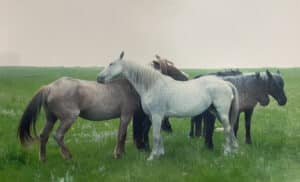ADS

The Indian horse originated from the domesticated and feral offspring of two types of horses – the Barb and the Andalusian – brought to the New World by the Spanish. Indian horses of the Northern Plains typically had a square-set, angular frame, tapering musculature, V-shaped front end, angular shoulders with prominent withers, a distinctly sloped croup, low tail set, and strongly built legs with a heavy “feathering” of long hair on their lower legs.
The relationship between an Indian horse and rider began at a young age. Boys were taught to ride at 6-7 years old. The skills needed to become a great horseman required many years of riding and training one’s horse.
By 12-13 years of age, boys would break horses by walking them into water and allowing them to buck out. Others were simply broke by kindness and patience.
Young boys tended to the horses by herding them to pasture for grazing, watering the horses, and watching out for horse thieves. Horses were housed inside or outside the lodge in corrals depending on the weather, status of the horse, and potential for raids.
Women were responsible for cleaning the corrals, removing the manure, and cutting grass for feed. In winter, they stripped cottonwood bark to feed the horses. In Mandan and Hidatsa houses, an enclosure was added to the right of the inner end of the entrance passage, where valuable horses were kept at night as a precaution against enemy raiders. Corrals were also built between the houses, often under the drying stages, to hold less valuable animals.
Horses used to hunt bison (or buffalo) were so well trained that they not only watched the buffalo to avoid collision but also kept a sharp lookout for holes and bad footing on the prairie. A horse was trained for the chase by riding alongside of and into herds of running horses. Rubbing the horse with buffalo robes would accustom him to the smell of the animals.

Nokota Horses [Photo: nokotahorses.org]
The Indian horse’s strength and endurance allowed hunters to carry home the meat and one hide of a buffalo cow, weighing approximately 300 lbs. Possessing great stamina, the Indian horse could cover 60-80 miles a day compared to the 30-40 mile range of a Cavalry horse.
Characteristics typical of the Indian horse can still be found today in the wild horses of the Little Missouri Badlands and Theodore Roosevelt National Park. In the late 1800s, the Marquis de Mores, founder of the town of Medora, purchased confiscated horses. These horses and other escaped ranch horses became part of wild herds. In the late 1940s, when the Theodore Roosevelt National Park was developed, a few wild horses were inadvertently enclosed within the park’s boundary fence. By 1960, they were the last surviving wild horses in North Dakota.
Indian horses have been designated the North Dakota State Horse and are recognized today as the Nokota Horse. Find more information at nokotahorse.org, and plan a visit to the NDCHF Center of Western Heritage & Cultures in Medora.

